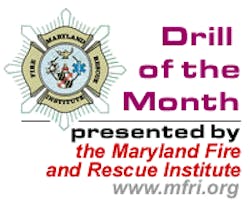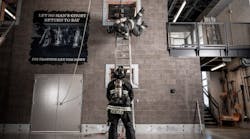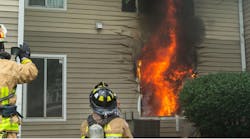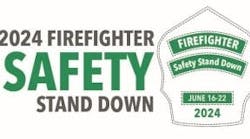Drill: Hazardous Materials Operations - Local Option
Session Reference: 1
Topic: Hazardous Materials Local Operations
Time Required: Three Hours
Materials:
*Hazardous Materials Response Unit
*Various Level A and Level B Suits
*Decontamination Equipment
*Chalkboard
References:
*Frederick County Hazardous Incident Response Team Standard Operating Procedures
*Frederick County Incident Command System
Preparation:
Motivation:
Objective (SPO): 1-1
The student will demonstrate a basic understanding of assistance activities and support to the hazardous materials team by applying
the information covered in practical activities.
Overview:
Hazardous Materials Local Operations
* Describe responsibilities prior to arrival of team
* Describe responsibilities upon arrival of team
* Demonstrate setting and operating decontamination station
* Demonstrate assisting donning chemical protective clothing
Session 1 Hazardous Materials Local Operations
SPO 1-1 The student will demonstrate a basic understanding of assistance activities and support to the hazardous materials team by applying the information covered in practical activities.
1 - 1 Describe the responsibilities of on scene personnel at a hazardous materials incident prior to the arrival of the hazardous materials team.
1 - 2 Describe the responsibilities of on scene personnel at a hazardous materials incident upon the arrival of the hazardous materials team.
1 - 3 Demonstrate setting and operating a decontamination station in support of a hazardous materials team.
1 - 4 Demonstrate assisting a member of a hazardous materials team to don chemical protective clothing.
NOTE: This material is intended to be taught following the Hazardous Materials Operations Course offered by the Maryland Fire and Rescue Institute. It can, however, also be used as a local Hazardous Materials Operations Refresher Drill.
I. Responsibilities Prior to Team Arrival (1-1)
A. Keep all personnel a safe distance from the hazard and do not permit any operations to take place which are beyond their capabilities (training and equipment)
B. Initiate incident command system and appoint scene safety officer
C. Maintain control over all emergency responders and civilians
D. Attempt to identify the problem
1. Product leaking or spilled
2. Form of product - solid, liquid, or vapor
3. Hazard of product - flammable, corrosive, or reactivity
4. Identification of product(s) - identification numbers, shipping papers, placards or labels, container
types or shape, type of occupancy, knowledgeable individual(s), pre-incident information
5. Type of container - transportation (non-pressurized or pressurized), fixed or stationery
(non-pressurized or pressurized) bag, box, drum, glass container, pail
6. Metering for combustibility - LEL
7. Other product information
E. Attempt to assess the risk
1. Reference materials – DOT Emergency Response Guide
2. Exposures - human, animal, structural, environmental
3. Resource available – staffing, apparatus, equipment, technical specialists
4. What already happened
5. What is likely to happen
F. Defensive measures
1. Establish the hot, warm, and cold zones
2. Control access to scene
3. Control and containment - diking, vapor suppression, container cooling, pooling
4. Evacuate people in immediate danger
5. Protect exposures
II. Responsibilities Upon Team Arrival (1-2)
A. Share problem and risk information
B. Explain actions taken
C. Determine appropriate course of action
1. No further fire department action required
2. Maintain current defensive action
3. Evacuate to safe distance
4. Initiate offensive action
a. Provide fire suppression support to team
b. Provide medical support to team
c. Provide personnel support for decontamination and donning chemical protective clothing
d. Provide personnel to assist with metering
e. Maintain liaison with incident commander
III . Setting Up and Operating Decontamination (1-3)
A. Identify the level of protective clothing required for decontamination
B. Identify the type of decontamination - wet or dry
C. Identify the number of stages in the decontamination station
D. Identify the decontamination solution
E. Identify the location of the decontamination station
F. Setting up decontamination station
1. Set up large containment area using plastic and 150 feet of 2-1/2-inch or 3-inch hose which has
been inflated with air
2. Mark off area with barrier tape and traffic
3. Identify clean side and dirty side of containment area
4. Set up containment areas within large containment area – wading pools with absorbent pads and
standing platforms
5. Set up tool drop, glove drop, and boot wash stations
6. Set up decontamination equipment - brushes, sprayers and hoses or vacuums, shower
7. Set up doffing area for removal of chemical protective clothing
8. Set up disposal area for contaminated materials and clothing
9. Set up inflatable shelter for disrobing of contaminated people
G. Operation of decontamination station
1. Identify personnel to staff station - one or two at each stage
2. Process personnel through medical evaluation - required for anyone donning chemical protective
clothing
3. Have personnel don appropriate protective clothing and SCBA
4. Assign personnel to stages
5. Review decontamination operations with personnel – must be done prior to entry
6. Personnel assume assigned positions
7. Once all entry personnel have been decontaminated, decontamination personnel must be
decontaminated
8. Process personnel through medical evaluation upon completion of assigned decontamination duties
9. Properly contain any contaminated runoff
10. Dismantle decontamination station
IV. Donning Chemical Protective Clothing (1-4)
A. Dressing Out in Chemical Protective Clothing
1. Assemble area with seating for donning clothing
2. Collect proper chemical protective suit, gloves, boots, SCBA, and radio for respective team
member
3. Assist with putting on surgical gloves
4. Assist with getting into legs of suit
5. Assist with putting on boots
6. Assist with putting on SCBA backpack and facepiece when Level A suits are used – leave low
pressure hose disconnected
7. Assist with putting on radio when Level A suits are used
8. Turn on air cylinder
9. Assist with getting in arms of suit
10. Assist with putting on any additional gloves required
11. Assist with putting on hood of suit
12 Zip up flap and pull draw strings in Level B suit is used
13. Assist with putting on SCBA backpack and facepiece when Level B suits are used – leave low
pressure hose disconnected
14. Assist with putting on radio when Level B suits are used
15. Tape around facepiece, glove wristlets, boot tops, and flaps if Level B suits are used
16. Put on air and note time – report time to team safety officer
17. Zip up suit if Level A is used
B. Reverse process for removal of suit, taking care not to touch the inside of the suit (the last item removed is the SCBA)
V. Practical Activities
A. Have the students demonstrate setting and operating a decontamination station.
B. Have the students demonstrate assisting a member of a hazardous materials team to don chemical protective clothing.
C. Student Evaluation - All students will be evaluated by the following means:
1. Oral questioning/class participation
2. Observed performance in classroom exercises.
Review:
Hazardous Materials Local Operations
* Describe responsibilities prior to arrival of team
* Describe responsibilities upon arrival of team
* Demonstrate setting and operating decontamination station
* Demonstrate assisting donning chemical protective clothing






